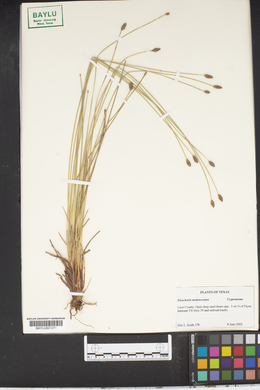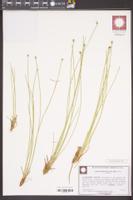Eleocharis melanocarpa
|
|
|
|
Family: Cyperaceae
Black-Fruit Spike-Rush, more...blackfruit spikerush
|
Culms to 2 times wider than thick, 35-60(-70) cm × 0.5-1.3 mm, hard, usually with to 10 blunt ribs, at 20X often finely ridged and minutely granular. Leaves: distal leaf sheaths brown to reddish. Spikelets 3-12 × 3-4 mm; proximal scale amplexicaulous, 3.5-4 mm, midrib region very broad and fleshy, apex entire; subproximal scale with a flower; floral scales 30-40, 8-10 per mm of rachilla, orange-brown to stramineous, midrib region stramineous, broadly ovate, papery or sometimes membranous, 3-4 × 2 mm, apex entire, rounded. Flowers: perianth bristles present, sometimes rudimentary, brown, length variable, obscurely retrorsely spinulose; anthers brown, 1.7-2.2 mm. Achenes subdeltoid in outline, sometimes broadly obpyriform, equilaterally trigonous, angles prominent, 0.9-1.2 × 0.7-1.1 mm, apex truncate. Tubercles sessile, depressed-pyramidal, often apiculate, as wide as achene, 0.3-0.5 × 0.7-1.1 mm. Fruiting summer. Fresh, oligotrophic, acid, sandy or peaty, often drying shores, ponds, ditches; 10-300 m; Ala., Fla., Ga., Ind., Mass., Mich., N.Y., N.C., R.I., S.C., Tex., Va. Eleocharis melanocarpa is reported from Rhode Island; I have not seen a voucher specimen.
Perennial herb, densely tufted 20 cm - 0.6 m tall Leaves: reduced to bladeless sheaths, basal, two per culm, margins fused and enclosing culm, brown to reddish, with a truncate (cut straight across) apex that often bears a tiny tooth. Flowers: minute, spirally arranged on the axis of the spikelet, lacking sepals and petals, with bristles, subtended by a scale. Bristles brown, of variable length. Stamens exserted. Anthers brown, 1 - 2 mm long. Pistil one. Fruit: a one-seeded achene, dark brown, about 1 mm long and 1 mm wide, nearly triangular, sometimes reverse pear-shaped, with a flat apex, three-angled (angles prominent). Tubercle stalkless, to about 0.5 mm long and 1 mm wide, as wide as achene, depressed pyramidal with a pointed apex. Seed with a thin, non-adherent wall. Culm: unbranched, firm, wiry, 20 cm - 0.6 m long, to about 1 mm wide, compressed to two times as wide as thick, often up to ten-ribbed, often finely ridged and with tiny granules (at 20X), enclosed basally by two fused sheaths. Spikelets: solitary, 3 - 15 mm long, 3 - 4 mm wide, narrowly egg-shaped with a blunt apex, with 30 to 40 floral scales. Scales spirally arranged and overlapping, straw-colored to orangish brown with a straw-colored midrib, 3 - 4 mm long, to 2 mm wide, broadly egg-shaped with a rounded apex, papery, sometimes membranous. Similar species: No information at this time. Flowering: June to mid-July Habitat and ecology: A coastal-plain disjunct found in moist sandy prairies. It is most frequent in areas of wet sand that are characterized by other coastal-plain disjuncts. Has also been found growing on a floating muck mat. Occurence in the Chicago region: native Etymology: Eleocharis comes from the Greek words heleios, meaning "dwelling in a marsh," and charis, meaning grace. Melanocarpa means "black fruit." Author: The Morton Arboretum Densely cespitose perennial; stems 2-6 dm, wiry, flattened, sometimes proliferous at the tip; sheaths truncate and prominently mucronulate; spikelet narrowly ovoid, 6-15 mm, obtuse, many-fld; scales firm, obtuse; bristles short or vestigial; anthers ca 1.3-2 mm; achene obpyramidal, trigonous with rounded angles, dark brown, 1 mm, truncate above; tubercle very flat, covering the summit of the achene and somewhat projecting at the margin, slightly elevated in the middle. Wet sand and pine- barrens, mostly near the coast; Mass. to Fla. and Tex., and inland in Mich. and Ind. Gleason, Henry A. & Cronquist, Arthur J. 1991. Manual of vascular plants of northeastern United States and adjacent Canada. lxxv + 910 pp. ©The New York Botanical Garden. All rights reserved. Used by permission. From Flora of Indiana (1940) by Charles C. Deam Wet or moist, sandy borders of marshes and sloughs. ...... Indiana Coefficient of Conservatism: C = 10 Wetland Indicator Status: FACW |
|
|
|












































































